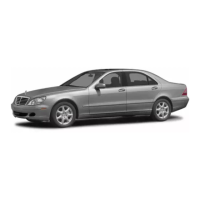
Do you have a question about the Mercedes-Benz S 420 and is the answer not in the manual?
| Brand | Mercedes-Benz |
|---|---|
| Model | S 420 |
| Category | Automobile |
| Language | English |
Guidelines for using Mercedes-Benz original parts and approved accessories for optimal reliability and safety.
Information on warranties covering your Mercedes-Benz, including new car, emission, and performance warranties.
Details California lemon law rights for vehicle replacement or refund after repair attempts.
Information on necessary maintenance work to be performed at regular intervals.
Provides factory-trained technical help in case of a breakdown, including a toll-free number.
Instructions for updating address or selling the vehicle to inform the manufacturer.
Awareness of service facilities and parts availability when operating vehicles in foreign countries.
Guidance on treating the vehicle during the initial break-in period for optimal performance.
Caution regarding the operation of radio transmitters and potential electronic system interference.
Detailed descriptions of gauges and indicators within the instrument cluster.
Explanation of various indicator lamps and their meanings for vehicle functions and warnings.
Information on the catalytic converter's function and maintenance recommendations for proper operation.
Procedures for starting and stopping the engine, including cold and hot engine conditions.
Information on brake and steering system power assistance when the engine is not running.
Guidance on brake usage, warnings about brake pad wear, and system maintenance.
Explanation of tread wear indicators and when tires should be replaced for safety.
Information on aquaplaning and how to drive cautiously in wet conditions.
Guidance on tire traction in different conditions and understanding tire speed ratings.
Step-by-step instructions for safely parking the vehicle, including engaging the parking brake.
Advice for driving in slippery conditions, including handling skidding and road salt effects.
Warning about securing items in the passenger compartment to prevent injury during accidents.
Description and operation of various air outlets within the cabin for ventilation.
Information on the dust filter's role in cleaning outside air entering the passenger compartment.
Details on master, valet, and flat keys, and obtaining replacement keys.
Instructions for using the infrared remote control for locking, unlocking, and window operation.
Operation of the central locking system for doors, trunk, and fuel filler flap.
Manual locking and unlocking of individual doors from inside and outside the vehicle.
Using the key in door or trunk locks to close windows and the sliding roof.
Operation of power windows and the sliding/pop-up roof, including express functions.
Automatic closing of doors and trunk lid via a pneumatic power-assisted mechanism.
Arming and disarming the anti-theft alarm system using keys or remote control.
Instructions for adjusting front seats, including warnings about adjusting while driving.
Description of inflatable lumbar support system and its pressure regulator.
Information on orthopedic seats with inflatable cushions for lumbar and side support.
Instructions for operating front and rear seat heaters, including power consumption.
Details on the front seat armrest with a compartment for a telephone handset.
How to adjust rear seats using slide switches located in the rear doors.
Description of the rear bench seat armrest with integrated storage compartment.
Operation of rear head restraints, including folding for visibility and safety.
How to operate rear power head restraints using switches on the console or doors.
Overview of seat belts, emergency tensioning retractors, and the Supplemental Restraint System (SRS).
Explanation of the seat belt warning system and audible alerts for unfastened belts.
Guidelines for correct seat belt positioning to maximize protection and avoid injury.
Recommendations for using infant and child restraint systems in accordance with safety standards.
Details on the ETR system which tightens seat belts during major frontal impacts.
Location and function of driver and passenger airbags, and system readiness verification.
Airbag activation limitations and the importance of seat belt usage for supplemental protection.
Guidance on seating positions to ensure safe distance from inflating airbags.
Legal requirements and recommendations for child restraint systems.
Operation of the combination switch for turn signals, headlights, and wipers.
Information on washer fluid mixing, wiper operation, and troubleshooting.
Controls for exterior lamps, including parking, low beam, high beam, and fog lamps.
How to use standing lamps for visibility when parking.
Adjustment of the inside rear view mirror and antiglare night position.
Explanation of multiple images in exterior mirrors due to dual-pane glass.
How to store exterior and inside mirror positions in memory for recall.
Usage of sun visors for glare protection, including side adjustment.
Operation of illuminated vanity mirrors in front and rear seats.
Operation of interior lamps based on door contact, delayed switching, and ignition status.
Control of front reading lamps and rear courtesy lamps for interior illumination.
Details on storage/eyeglasses compartments and the glove box.
Description of door pockets and compartments for items like umbrellas.
Operation and maintenance of ashtrays and the cigarette lighter.
Operation of the sliding roof and pop-up feature, including manual emergency procedures.
Description of power window switches located in the center console and rear doors.
Using express open/close functions for windows and interrupt procedures.
Procedure to resynchronize power windows after a power supply interruption.
Operation of the rear window sunshade for raising and lowering.
Operation of the rear window defroster, including automatic shut-off and power consumption.
How to open the trunk using the console switch or the infrared remote control.
Adjusting instrument panel illumination and understanding display illumination.
Resetting the trip odometer and setting the vehicle's clock.
Warning against storing objects on the rear window shelf due to potential injury.
Information on cellular telephone installation and safety warnings regarding mobile phone use while driving.
Serious warnings about the dangers of drinking and driving.
Instructions for engaging and releasing the parking brake and associated warning lamp.
Steps for safely driving off, including testing brakes and warming up the engine.
How the automatic transmission selects gears based on vehicle speed and accelerator position.
Understanding accelerator pedal positions for shifting and kickdown for maximum acceleration.
Guidance on stopping the vehicle, including warnings about parking on inclines.
Advice on driving on slippery roads, including warnings against downshifting.
Techniques for maneuvering and stopping on inclines, with warnings about parking brake usage.
Description of rear fender indicators that extend when reversing.
How to operate the cruise control system for maintaining set speeds.
Information on the charge indicator lamp and potential causes for illumination.
Interpreting engine oil pressure gauge and low oil level warning lamp.
Factors affecting engine oil consumption, especially during the break-in period.
Explanation of the fuel consumption gauge readings in MPG or L/100 km.
Understanding the tachometer, redline limits, and engine speed warnings.
Explanation of the fuel reserve warning lamp and the outside temperature indicator.
Interpreting the coolant temperature gauge and warnings about engine overheating.
Information on the washer fluid level warning lamp and reservoir refill.
How the exterior lamp failure indicator works and what it signifies.
Explanation of seat belt warning and brake pad wear indicator lamps.
How ABS improves steering control during braking and its operational principles.
How ETS improves traction, especially on slippery roads, and its operational limits.
How ADS automatically adjusts ride firmness based on driving conditions and style.
Selecting between firm and soft damping programs for sporty or regular driving.
Information on emission control systems and maintenance requirements.
How the diagnostic system monitors emission components and indicates malfunctions.
Advice for winterizing the car, including engine oil, coolant, and tire recommendations.
Guidelines for using snow chains, including approved types and speed limitations.
Procedure for opening and closing the vehicle hood, with safety warnings.
Instructions for checking coolant level and adding coolant when necessary.
Recommendations for the coolant mixture and potential hazards associated with adding coolant.
How to switch the trunk lamp on or off to prevent battery discharge.
Location and removal of the spare wheel and lug wrench from the trunk.
Location of the first aid kit and guidelines for safely stowing items in the vehicle.
Safe procedures for using the vehicle jack, including warnings about stability and safety.
Location and access to the tool box storage compartment.
Information on recommended tire types, sizes, and wheel specifications.
Guidelines for replacing tires, including rotation recommendations and bolt tightening.
Steps for installing wheel bolts, including warnings about damaged threads or bolts.
Recommendations for tire inflation pressure based on load and temperature conditions.
Warnings against overinflating tires or overloading the vehicle to prevent blowouts.
Instructions for battery maintenance, charging, and disconnection procedures.
Information on battery recycling and safety warnings related to battery handling.
Overview of exterior lamp components and replacement guidelines.
Identification of parts within the headlamp assembly for bulb replacement.
Replacement procedure for turn signal, parking, side marker, and standing lamps.
Instructions on how to adjust headlamp aim for proper road illumination.
Procedure for replacing the bulb in the high mounted stop lamp.
Location of fuse boxes and guidelines for replacing blown fuses.
Step-by-step instructions for jump starting a vehicle with a dead battery.
Recommendations for towing the vehicle, including flatbed transport and speed limits.
Precautions when towing with vehicles equipped with ASR or ETS to prevent system engagement.
Warnings about using cleaning products and general care for the vehicle's exterior.
Procedures for removing tar stains, cleaning windows, and replacing wiper blades.
Care instructions for plastic parts, seat belts, and interior surfaces.
Guidelines for cleaning and maintaining leather upholstery to prevent discoloration.
Recommendations for maintaining paintwork, gloss preserver, and polish.
Cleaning procedures for light alloy wheels and care for ornamental moldings.
How to test remote control batteries and procedures for changing them.
Steps to re-synchronize the remote control system after a voltage interruption.
Detailed instructions for removing and installing front head restraints.
Procedure for manually closing the trunk lid in case of power system malfunction.
How to manually release the fuel filler flap if the central locking system fails.
Step-by-step guide for replacing windshield wiper blades.
Procedure for replacing the wiper blades on the headlamp washers.
Manual operation of the sliding roof in case of electrical malfunction.
Guidelines for installing approved roof racks to avoid vehicle damage.
Diagrams showing the layout of the poly-V-belt drive for different S-Class models.
Instructions for removing and installing the rear seat cushion.
Information on the availability and quality of genuine Mercedes-Benz original spare parts.
Location of vehicle identification and engine numbers for ordering spare parts.
Importance of the vehicle data card for key replacement and service information.
Overview of warranty coverage, including new vehicle, emission systems, and performance warranties.
Specifications for weights, dimensions, engine, electrical system, and tires for the S 320 model.
Specifications for weights, dimensions, engine, electrical system, and tires for the S 420 model.
Information on downshift points for transmission control in various driving conditions.
Specifications for weights, dimensions, engine, electrical system, and tires for the S 500 model.
Recommendations for engine oils and warnings against using oil additives.
Information on refrigerant types and brake fluid maintenance and replacement intervals.
Precautions when using regular gasoline if premium unleaded is unavailable.
Specifications for premium unleaded gasoline, octane number, and oxygenate usage.
Recommendations for using quality gasoline additives to prevent carbon deposits.
Information on engine coolant mixture, freeze protection, and corrosion protection.
Explanation of tire grades for treadwear, traction, and temperature resistance.
Understanding tire grades related to braking traction and heat resistance.
Instructions on how to report vehicle problems to an authorized dealer or regional office.
Guidance on reporting vehicle defects that could cause crashes or injuries to NHTSA.
Importance of using authorized Mercedes-Benz dealers for service and repairs.
How to obtain service literature for your vehicle from an authorized dealer.
Procedures for checking fuel supply and tire inflation pressure regularly.
Instructions for checking coolant level, engine oil level, and brake fluid.
Information on fuel types, engine oil checks, and transmission fluid level checks.
Details on coolant, spark plugs, bulb types, and tire pressure.









